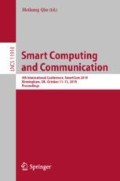Abstract
In order to solve the problems of low IP capacity and low robustness in existing IP watermarking techniques, this paper proposed a novel recoverable IP watermarking algorithm based on Shamir threshold model. This method takes \( \left( {t,n} \right) \) the threshold secret sharing scheme with t as the recovery factor. By constructing a mapping relationship among n sub-keys and watermark information S, n sub-keys of watermark cross-inserted into the respective watermark information S, and finally the embedded watermark information S is reconstructed. Experiment result shows that this method greatly improves the robustness of the watermark while expanding watermark information capacity. Compared to others watermarking algorithms, this method has the advantages of large watermark embedding capacity and high watermark recovery ability.
Access this chapter
Tax calculation will be finalised at checkout
Purchases are for personal use only
References
Liang, W., Xie, S., Li, X., Long, J., Xie, Y., Li, K.-C.: A novel lightweight PUF-based RFID mutual authentication protocol. In: Hung, J.C., Yen, N.Y., Hui, L. (eds.) FC 2017. LNEE, vol. 464, pp. 345–355. Springer, Singapore (2018). https://doi.org/10.1007/978-981-10-7398-4_36
Liang, W., Long, J., Cui, A., et al.: A new robust dual intellectual property watermarking algorithm based on field programmable gate array. J. Comput. Theor. Nanosci. 12(10), 3959–3962 (2015)
Han, Q., Noura, H., Qiu, M., et al.: A user-centric data protection method for cloud storage based on invertible DWT. IEEE Trans. Cloud Comput., 1 (2019)
Anirban, S., Dipanjan, R.: Antipiracy-aware IP chipset design for CE devices: a robust watermarking approach hardware matters. IEEE Consum. Electron. Mag. 6(2), 118–124 (2017)
Han, Q., Noura, H., et al.: All-or-nothing data protection for ubiquitous communication: challenges and perspectives. Inf. Sci. 502, 434–445 (2019)
Anirban, S., Saumya, B., Saraju, M.P.: Embedding low cost optimal watermark during high level synthesis for reusable IP core protection. In: IEEE International Symposium on Circuits & Systems, pp. 974–977. IEEE (2016)
Abtioglu, E., Yeniceri, R., Govem, B., et al.: Partially reconfigurable IP protection system with ring oscillator based physically unclonable functions, pp. 58–65. IEEE (2017)
Zhang, J., Lin, Y., Qu, G.: Reconfigurable binding against FPGA replay attacks. ACM Trans. Des. Autom. Electron. Syst. 20(2), 1–20 (2015)
Cui, A., Qu, G., Zhang, Y.: Ultra-low overhead dynamic watermarking on scan design for hard IP protection. IEEE Trans. Inf. Forensics Secur. 10(11), 2298–2313 (2017)
Liang, W., Huang, W., Chen, W., et al.: Hausdorff distance model-based identity authentication for IP circuits in service-centric internet-of-things environment. Sensors 19(3), 487 (2019)
Liang, W., Long, J., Zhang, D., Li, X., Huang, Y.: Study on IP protection techniques for integrated circuit in IOT environment. In: Di Martino, B., Li, K.-C., Yang, L.T., Esposito, A. (eds.) Internet of Everything. IT, pp. 193–216. Springer, Singapore (2018). https://doi.org/10.1007/978-981-10-5861-5_9
Sengupta, A., Bhadauria, S.: Exploring low cost optimal watermark for reusable IP cores during high level synthesis. IEEE Access 4, 2198–2215 (2016)
OpenCores Web Site. http://www.opencores.org. Accessed 25 Jan 2019
Acknowledgements
This research was funded by the Fujian Provincial Natural Science Foundation of China (Grant 2018J01570) and the CERNET Innovation Project (Grant NGII20170411).
Author information
Authors and Affiliations
Corresponding author
Editor information
Editors and Affiliations
Rights and permissions
Copyright information
© 2019 Springer Nature Switzerland AG
About this paper
Cite this paper
Xiao, W. et al. (2019). A Shamir Threshold Model Based Recoverable IP Watermarking Scheme. In: Qiu, M. (eds) Smart Computing and Communication. SmartCom 2019. Lecture Notes in Computer Science(), vol 11910. Springer, Cham. https://doi.org/10.1007/978-3-030-34139-8_32
Download citation
DOI: https://doi.org/10.1007/978-3-030-34139-8_32
Published:
Publisher Name: Springer, Cham
Print ISBN: 978-3-030-34138-1
Online ISBN: 978-3-030-34139-8
eBook Packages: Computer ScienceComputer Science (R0)

